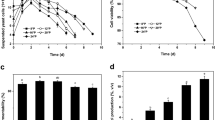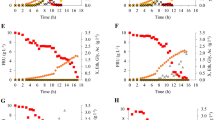Abstract
The rapid and efficient consumption of carbon and nitrogen sources by brewer’s yeast is critical for the fermentation process in the brewing industry. The comparison of the growth characterizations of typical ale and lager yeast, as well as their consumption preference to carbon and nitrogen sources were investigated in this study. Results showed that the ale strain grew faster and had a more extended stationary phase than the lager strain. However, the lager strain was more tolerant to the stressful environment in the later stage of fermentation. Meanwhile, the ale and lager yeast strains possessed varying preferences for metabolizing the specific fermentable sugar or free amino acid involved in the wort medium. The lager strain had a strong capacity to synthesize the extracellular invertase required for hydrolyzing sucrose as well as a strong capability to metabolize glucose and fructose. Furthermore, the lager strain had an advantage in consuming Lys, Arg, Val, and Phe, whereas the ale strain had a higher assimilation rate in consuming Tyr. These findings provide valuable insights into selecting the appropriate brewer’s yeast strain based on the wort components for the industrial fermentation process.
Key points
• The lager strain is more tolerant to the stressful environment.
• The lager strain has the great capability to synthesize the extracellular invertase.
• The assimilation efficiency of free amino acid varies between ale and lager.
Graphical abstract






Similar content being viewed by others
Data availability
The authors confirm that the data supporting the findings of this study are available within the article.
References
Avramia I, Amariei S (2021) Spent brewer’s yeast as a source of insoluble β-glucans. Int J Mol Sci 22(2):825. https://doi.org/10.3390/ijms22020825
Berlowska J, Kregiel D, Rajkowska K (2015) Biodiversity of brewery yeast strains and their fermentative activities. Yeast 32(1):289–300. https://doi.org/10.1002/yea.3041
Bhonsale S, Mores W, Van Impe J (2021) Dynamic optimisation of beer fermentation under parametric uncertainty. Fermentation 7(4):285. https://doi.org/10.3390/fermentation7040285
Boyd AR, Gunasekera TS, Attfield PV, Simic K, Vincent SF, Veal DA (2003) A flow-cytometric method for determination of yeast viability and cell number in a brewery. FEMS Yeast Res 3(1):11–16. https://doi.org/10.1111/j.1567-1364.2003.tb00133.x
Brouwers N, Brickwedde A, de Vries ARG, van den Broek M, Weening SM, van den Eijnden L, Diderich JA, Bai F-Y, Pronk JT, Daran J-MG (2019) Himalayan Saccharomyces eubayanus genome sequences reveal genetic markers explaining heterotic maltotriose consumption by Saccharomyces pastorianus hybrids. Appl Environ Microbiol 85(22):e01516-e1519. https://doi.org/10.1128/AEM.01516-19
Capece A, Romaniello R, Siesto G, Romano P (2018) Conventional and non-conventional yeasts in beer production. Fermentation 4(2):38. https://doi.org/10.3390/fermentation4020038
Chenot C, Donck W, Janssens P, Collin S (2022) Malt and hop as sources of thiol S-conjugates: thiol-releasing property of lager yeast during fermentation. J Agric Food Chem 70(10):3272–3279. https://doi.org/10.1021/acs.jafc.1c07272
D’Amore T, Russell I, Stewart GG (1989) Sugar utilization by yeast during fermentation. J Ind Microbiol 4(4):315–323. https://doi.org/10.1007/BF01577355
Ernandes JR, Williams JW, Russell I, Stewart GG (1993) Effect of yeast adaptation to maltose utilization on sugar uptake during the fermentation of brewer’s wort. J Inst Brew 99(1):67–71. https://doi.org/10.1002/j.2050-0416.1993.tb01149.x
Espinosa-Ramírez J, Pérez-Carrillo E, Serna-Saldívar SO (2014) Maltose and glucose utilization during fermentation of barley and sorghum lager beers as affected by β-amylase or amyloglucosidase addition. J Cereal Sci 60(3):602–609. https://doi.org/10.1016/j.jcs.2014.07.008
Ferreira IMPLVO, Pinho O, Vieira E, Tavarela JG (2010) Brewer’s Saccharomyces yeast biomass: characteristics and potential applications. Trends Food Sci Technol 21(2):77–84. https://doi.org/10.1016/j.tifs.2009.10.008
Gibson BR, Storgårds E, Krogerus K, Vidgren V (2013) Comparative physiology and fermentation performance of Saaz and Frohberg lager yeast strains and the parental species Saccharomyces eubayanus. Yeast 30(7):255–266. https://doi.org/10.1002/yea.2960
He Y, Dong J, Yin H, Zhao Y, Chen R, Wan X, Chen P, Hou X, Liu J, Chen L (2014) Wort composition and its impact on the flavour-active higher alcohol and ester formation of beer – a review. J Inst Brew 120(3):157–163. https://doi.org/10.1002/jib.145
He Y, Cao Y, Chen S, Ma C, Zhang D, Li H (2018) Analysis of flavour compounds in beer with extruded corn starch as an adjunct. J Inst Brew 124(1):9–15. https://doi.org/10.1002/jib.474
Hill AE, Stewart GG (2019) Free amino nitrogen in brewing. Fermentation 5(1):22. https://doi.org/10.3390/fermentation5010022
Jiang L, Qi M, Deng Y, Suo W, Song J, Zhang M, Zheng H, Zhang D, Chen S, Li H (2022) Extrusion-induced pre-gelatinization and hydrolyzation of rice adjunct contributed to the mashing performance. LWT-Food Sci Technol 158:113126. https://doi.org/10.1016/j.lwt.2022.113126
Jiang L, Song J, Qi M, Suo W, Deng Y, Liu Y, Li L, Zhang D, Wang C, Li H (2023) Modification mechanism of protein in rice adjuncts upon extrusion and its effects on nitrogen conversion during mashing. Food Chem 407:135150. https://doi.org/10.1016/j.foodchem.2022.135150
Krogerus K, Magalhães F, Vidgren V, Gibson B (2017) Novel brewing yeast hybrids: creation and application. Appl Microbiol Biotechnol 101(1):65–78. https://doi.org/10.1007/s00253-016-8007-5
Lei H, Zhao H, Yu Z, Zhao M (2012) Effects of wort gravity and nitrogen level on fermentation performance of brewer’s yeast and the formation of flavor volatiles. Appl Biochem Biotechnol 166(6):1562–1574. https://doi.org/10.1007/s12010-012-9560-8
Lei H, Zheng L, Wang C, Zhao H, Zhao M (2013) Effects of worts treated with proteases on the assimilation of free amino acids and fermentation performance of lager yeast. Int J Food Microbiol 161(2):76–83. https://doi.org/10.1016/j.ijfoodmicro.2012.11.024
Lei H, Xu H, Feng L, Yu Z, Zhao H, Zhao M (2016) Fermentation performance of lager yeast in high gravity beer fermentations with different sugar supplementations. J Biosci Bioeng 122(5):583–588. https://doi.org/10.1016/j.jbiosc.2016.05.004
Lei H, Feng L, Peng F, Xu H (2019) Amino acid supplementations enhance the stress resistance and fermentation performance of lager yeast during high gravity fermentation. Appl Biochem Biotechnol 187(2):540–555. https://doi.org/10.1007/s12010-018-2840-1
Magalhães F, Vidgren V, Ruohonen L, Gibson B (2016) Maltose and maltotriose utilisation by group I strains of the hybrid lager yeast Saccharomyces pastorianus. FEMS Yeast Res 16(5):fow053. https://doi.org/10.1093/femsyr/fow053
Martı́nez-Rodrı́guez AJ, Polo MC, Carrascosa AV (2001) Structural and ultrastructural changes in yeast cells during autolysis in a model wine system and in sparkling wines. Int J Food Microbiol 71(1):45–51. https://doi.org/10.1016/S0168-1605(01)00554-2
Meneses FJ, Henschke PA, Jiranek V (2002) A survey of industrial strains of Saccharomyces cerevisiae reveals numerous altered patterns of maltose and sucrose utilisation. J Inst Brew 108(3):310–321. https://doi.org/10.1002/j.2050-0416.2002.tb00556.x
Piddocke MP, Kreisz S, Heldt-Hansen HP, Nielsen KF, Olsson L (2009) Physiological characterization of brewer’s yeast in high-gravity beer fermentations with glucose or maltose syrups as adjuncts. Appl Microbiol Biotechnol 84(3):453–464. https://doi.org/10.1007/s00253-009-1930-y
Powell CD, Quain DE, Smart KA (2003) The impact of brewing yeast cell age on fermentation performance, attenuation and flocculation. FEMS Yeast Res 3(2):149–157. https://doi.org/10.1016/S1567-1356(03)00002-3
Puligundla P, Mok C, Park S (2020) Advances in the valorization of spent brewer’s yeast. Innovative Food Sci Emerg Technol 62:102350. https://doi.org/10.1016/j.ifset.2020.102350
Quek WP, Yu W, Tao K, Fox GP, Gilbert RG (2019) Starch structure-property relations as a function of barley germination times. Int J Biol Macromol 136:1125–1132. https://doi.org/10.1016/j.ijbiomac.2019.06.149
Saerens SMG, Duong CT, Nevoigt E (2010) Genetic improvement of brewer’s yeast: current state, perspectives and limits. Appl Microbiol Biotechnol 86(5):1195–1212. https://doi.org/10.1007/s00253-010-2486-6
Stewart GG (2016) Saccharomyces species in the production of beer. Beverages 2(4):34. https://doi.org/10.3390/beverages2040034
Stewart GG, Hill AE, Russell I (2013) 125th Anniversary review: developments in brewing and distilling yeast strains. J Inst Brew 119(4):202–220. https://doi.org/10.1002/jib.104
Tokpohozin SE, Fischer S, Becker T (2019) Selection of a new Saccharomyces yeast to enhance relevant sorghum beer aroma components, higher alcohols and esters. Food Microbiol 83:181–186. https://doi.org/10.1016/j.fm.2019.05.014
Verbelen PJ, Delvaux FR (2009) Brewing yeast in action: beer fermentation. Appl Mycol 7:110–135. https://doi.org/10.1079/9781845935344.0110
Viana AC, Pimentel TC, Borges do Vale R, Clementino LS, Januario Ferreira ET, Magnani M, dos Santos LM (2021) American pale ale craft beer: influence of brewer’s yeast strains on the chemical composition and antioxidant capacity. LWT-Food Sci Technol 152:112317. https://doi.org/10.1016/j.lwt.2021.112317
Vidgren V, Multanen J-P, Ruohonen L, Londesborough J (2010) The temperature dependence of maltose transport in ale and lager strains of brewer’s yeast. FEMS Yeast Res 10(4):402–411. https://doi.org/10.1111/j.1567-1364.2010.00627.x
Wang J, Ding H, Zheng F, Li Y, Liu C, Niu C, Li Q (2019) Physiological changes of beer brewer’s yeast during serial beer fermentation. J Am Soc Brew Chem 77(1):10–20. https://doi.org/10.1080/03610470.2018.1546030
Yabaci Karaoglan S, Jung R, Gauthier M, Kinčl T, Dostálek P (2022) Maltose-negative yeast in non-alcoholic and low-alcoholic beer production. Fermentation 8(6):273. https://doi.org/10.3390/fermentation8060273
Yang H, Zong X, Xu Y, Li W, Zeng Y, Zhao H (2019) Efficient fermentation of very high-gravity worts by brewer’s yeast with wheat gluten hydrolysates and their ultrafiltration fractions supplementations. LWT-Food Sci Technol 106:151–157. https://doi.org/10.1016/j.lwt.2019.02.068
Yerolla R, Mehshan KMM, Roy N, Harsha NS, Pavan Ganesh MP, Besta CS (2022) Beer fermentation modeling for optimum flavor and performance. IFAC-PapersOnLine 55(1):381–386. https://doi.org/10.1016/j.ifacol.2022.04.063
Acknowledgements
This research was financially supported by the Key Research and Development Program of Shandong Province (Major Scientific and Technological Innovation Project, No. 2022CXGC010604).
Author information
Authors and Affiliations
Contributions
Conceptualization: L.J.; methodology: L.J.; writing—original draft preparation: L.J.; writing—review and editing: D.Z., C.W., H.L.; investigation: J.S., M.Q., Y.C., Y.L., M.X., L.L.; project administration: H.L.; funding acquisition: H.L.; and all authors read and approved the manuscript.
Corresponding author
Ethics declarations
Ethical approval
This work does not contain any studies with human participants or animals performed by any of the authors.
Conflict of interest
The authors declare no competing interests.
Additional information
Publisher's note
Springer Nature remains neutral with regard to jurisdictional claims in published maps and institutional affiliations.
Rights and permissions
Springer Nature or its licensor (e.g. a society or other partner) holds exclusive rights to this article under a publishing agreement with the author(s) or other rightsholder(s); author self-archiving of the accepted manuscript version of this article is solely governed by the terms of such publishing agreement and applicable law.
About this article
Cite this article
Jiang, L., Song, J., Qi, M. et al. Carbon and nitrogen sources consumption by ale and lager yeast strains: a comparative study during fermentation. Appl Microbiol Biotechnol 107, 6937–6947 (2023). https://doi.org/10.1007/s00253-023-12778-9
Received:
Revised:
Accepted:
Published:
Issue Date:
DOI: https://doi.org/10.1007/s00253-023-12778-9




